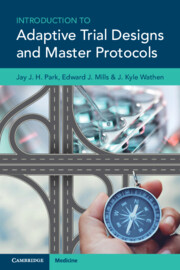Book contents
- Introduction to Adaptive Trial Designs and Master Protocols
- Introduction to Adaptive Trial Designs and Master Protocols
- Copyright page
- Content
- Preface
- About the Authors
- Part I Introduction and History of Clinical Trial Research
- Part II Basic Ingredients for Adaptive Trial Designs and Common Types
- Chapter 3 Characteristics and Principles of Adaptive Trial Designs
- Chapter 4 Common Types of Adaptive Trial Designs
- Chapter 5 Clinical Trial Simulations
- Part III Basic Ingredients for Master Protocols
- Part IV Case Studies of Adaptive Trial Designs and Master Protocols
- Part V A Practical Guide to Adaptive Trial Designs and Master Protocols
- Index
- References
Chapter 4 - Common Types of Adaptive Trial Designs
from Part II - Basic Ingredients for Adaptive Trial Designs and Common Types
Published online by Cambridge University Press: 20 March 2023
- Introduction to Adaptive Trial Designs and Master Protocols
- Introduction to Adaptive Trial Designs and Master Protocols
- Copyright page
- Content
- Preface
- About the Authors
- Part I Introduction and History of Clinical Trial Research
- Part II Basic Ingredients for Adaptive Trial Designs and Common Types
- Chapter 3 Characteristics and Principles of Adaptive Trial Designs
- Chapter 4 Common Types of Adaptive Trial Designs
- Chapter 5 Clinical Trial Simulations
- Part III Basic Ingredients for Master Protocols
- Part IV Case Studies of Adaptive Trial Designs and Master Protocols
- Part V A Practical Guide to Adaptive Trial Designs and Master Protocols
- Index
- References
Summary
This chapter discusses the common types of adaptive trial designs and their motivations and challenges. The common types covered in this chapter include: sequential designs, sample size re-assessment, adaptive randomisation, minimisation, response adaptive randomisation, enrichment design, and seamless design. Sequential designs that use interim analyses to allow for early stopping are the most common type of adaptive trial design. Sequential designs are often used with other types of adaptive trial designs. Other common types of adaptive trial designs include sample size re-assessment that uses blinded or unblinded data for re-estimation of sample size during the trial; response adaptive randomisation that preferentially increases allocation ratio in favour of treatment arm based on interim trial data; adaptive enrichment design that allows for modification of patient eligibility criteria; and seamless design that combines two phases of clinical trial research into one trial. Adaptive trial designs offer more flexibility in comparison to conventional fixed trial designs, but this comes with complexities that usually require more thorough and thoughtful planning in the design stage. Trade-offs for different design options should be carefully considered.
Keywords
- Type
- Chapter
- Information
- Publisher: Cambridge University PressPrint publication year: 2023



